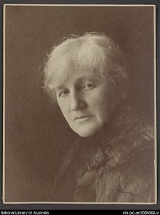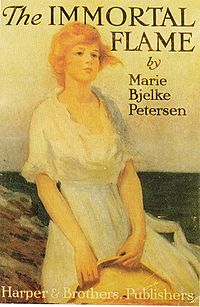
Marie Bjelke Petersen
Encyclopedia
Marie Caroline Bjelke Petersen (23 December 1874 – 11 October 1969) was a Danish-born Australian novelist and physical culture teacher. She wrote nine popular romance novels between 1917 and 1937. Her novels were set in Australia, mostly in rural Tasmania
, and represent an alternative vision of Australia to that of earlier writers.
Marie Bjelke Petersen's biographer, Alison Alexander, wrote:
"With her Danish background Marie was not steeped in the laconic lore of the bush propagated by the Bulletin
and its school of admirers, and she set out to glorify her adopted land, to depict Australia as a cultured civilised place, with charming people (setting aside the villains), a quite different portrayal from that usually found in the literature of her day."
It has been claimed that her works were more popular in the USA and England than Australia.
Her brothers founded physical culture institutes which continued to function through the end of the 20th century, and her nephew, Joh Bjelke-Petersen
, became the Premier of Queensland.
Marie Bjelke Petersen was trained as a painter in Denmark. She continued to paint for many years in Australia, mostly oil landscapes. She often wintered in Brisbane, Sydney or Melbourne where she would take a flat and hold religious meetings. She attracted a large following of young women as was common with female romantic novelists of her time.
While she enjoyed mythology and would write notes to fairies in her garden, she was a committed Christian who "never overlooked the poor and needy". A conservative herself, she numbered among her friends Marie Pitt
the poet and socialist activist who lived openly and indeed notoriously with her married lover. Gardening and reading were interests that Marie Bjelke Petersen continued into her nineties.
By the late 20th century, Bjelke Petersen had become a gay and lesbian icon. She lived in an intimate relationship with Sylvia Mills, whom she met in 1898, for thirty years. It has been argued that her book The Captive Singer is about Mills. She was not necessarily a lesbian however, or at least not seen as such in her own time; close sentimental women's friendships were still not assumed to be sexual in 1920s Australia.
In the mid 1890s, the Bjelke-Petersens learnt of the new game, basketball, that was becoming popular in the United States. Marie is credited with introducing drills designed specifically for players of the game into the physical culture program she taught in schools. "It can be argued, therefore, that Marie Bjelke Petersen was instrumental in introducing the sport of netball
to Tasmania." She was also a registered massage therapist.
 She had short sketches and stories published in various newspapers and magazines before achieving success with her first novel. Three religious tracts were published as The Mysterious Stranger (1913), Before an Eastern Court (1914) and Muffled Drums (1914). The success of the first of these tracts helped her to find a publisher for her first novel, The Captive Singer (1917). It was based on a guide who sang at Tasmania's Marakoopa Cave and was a financial success selling 150,000 copies in English and a further 40,000 in Danish translation. This first novel established Marie Bjelke Petersen as a significant Australian writer.
She had short sketches and stories published in various newspapers and magazines before achieving success with her first novel. Three religious tracts were published as The Mysterious Stranger (1913), Before an Eastern Court (1914) and Muffled Drums (1914). The success of the first of these tracts helped her to find a publisher for her first novel, The Captive Singer (1917). It was based on a guide who sang at Tasmania's Marakoopa Cave and was a financial success selling 150,000 copies in English and a further 40,000 in Danish translation. This first novel established Marie Bjelke Petersen as a significant Australian writer.
Bjelke Petersen approached Australian-born Hollywood actress Louise Lovely
with her story Jewelled Nights suggesting it might suit Lovely. Louise Lovely liked the story and produced a film of the same name with her partner, Wilton Welch, in 1925. However, it was not a commercial success, recovering £5,000 of its £10,000 production cost. The film had its critics, some regarded its primary weakness as its plot which involved a girl disguising herself as a boy. However the film was a popular success in Australia and overall the critics were friendly - another explanation was that this ambitious film fell victim to structural distribution problems facing the Australian film industry.
Her novels were distinguished by a fresh literary take on Australian life, closely observed scenery and social background and, by the standards of the romance genre, comparatively non-stereotyped characterisation and plot. Despite her conservative politics they were also notable for their celebration of Australian egalitarianism and her promotion of women's rights at a time when (and a place where) the women's movement was largely quiescent. Her novels also reflected her devout Christianity. A striking feature of her novels was their intense feeling for landscape, almost to the extent of ascribing sentience to natural features.
Her novels sold altogether around 250,000 copies in English, a phenomenal success for an Australian writer at that time. They were also translated into six languages, including Arabic.
In 1935 she won the King's Jubilee medal for services to literature.
Tasmania
Tasmania is an Australian island and state. It is south of the continent, separated by Bass Strait. The state includes the island of Tasmania—the 26th largest island in the world—and the surrounding islands. The state has a population of 507,626 , of whom almost half reside in the greater Hobart...
, and represent an alternative vision of Australia to that of earlier writers.
Marie Bjelke Petersen's biographer, Alison Alexander, wrote:
"With her Danish background Marie was not steeped in the laconic lore of the bush propagated by the Bulletin
The Bulletin
The Bulletin was an Australian weekly magazine that was published in Sydney from 1880 until January 2008. It was influential in Australian culture and politics from about 1890 until World War I, the period when it was identified with the "Bulletin school" of Australian literature. Its influence...
and its school of admirers, and she set out to glorify her adopted land, to depict Australia as a cultured civilised place, with charming people (setting aside the villains), a quite different portrayal from that usually found in the literature of her day."
It has been claimed that her works were more popular in the USA and England than Australia.
Her brothers founded physical culture institutes which continued to function through the end of the 20th century, and her nephew, Joh Bjelke-Petersen
Joh Bjelke-Petersen
Sir Johannes "Joh" Bjelke-Petersen, KCMG , was an Australian politician. He was the longest-serving and longest-lived Premier of Queensland, holding office from 1968 to 1987, a period that saw considerable economic development in the state...
, became the Premier of Queensland.
Life
Marie Bjelke Petersen was the only daughter and second child of Georg Peter Bjelke-Petersen, a gardener and then master builder, and his wife Caroline Vilhelmine, née Hansen. (Originally plain "Petersen" Georg hyphenated his name for unknown reasons sometime in the 1860s.) Marie went to school in Denmark, Germany and England but lived most of her life in Tasmania after emigrating with her parents and four brothers in 1891. She was naturalised in 1915.Marie Bjelke Petersen was trained as a painter in Denmark. She continued to paint for many years in Australia, mostly oil landscapes. She often wintered in Brisbane, Sydney or Melbourne where she would take a flat and hold religious meetings. She attracted a large following of young women as was common with female romantic novelists of her time.
While she enjoyed mythology and would write notes to fairies in her garden, she was a committed Christian who "never overlooked the poor and needy". A conservative herself, she numbered among her friends Marie Pitt
Marie Pitt
Marie Elizabeth Josephine Pitt was an Australian poet and socialist activist, also journalist and Unitarian. Pitt wrote very highly coloured nature poetry, once much anthologised; and also wrote poetry in support of the socialist and labour movements...
the poet and socialist activist who lived openly and indeed notoriously with her married lover. Gardening and reading were interests that Marie Bjelke Petersen continued into her nineties.
By the late 20th century, Bjelke Petersen had become a gay and lesbian icon. She lived in an intimate relationship with Sylvia Mills, whom she met in 1898, for thirty years. It has been argued that her book The Captive Singer is about Mills. She was not necessarily a lesbian however, or at least not seen as such in her own time; close sentimental women's friendships were still not assumed to be sexual in 1920s Australia.
Career in physical culture
In 1892, her brother Lt Col Hans Christian Bjelke-Petersen founded the Bjelke-Petersen Physical Culture School. (He is credited with building Australia's first squash court, shortly after World War I.) Marie was in charge of the women's section and taught there and at other schools before turning to writing in 1910 when injury meant she could no longer teach.In the mid 1890s, the Bjelke-Petersens learnt of the new game, basketball, that was becoming popular in the United States. Marie is credited with introducing drills designed specifically for players of the game into the physical culture program she taught in schools. "It can be argued, therefore, that Marie Bjelke Petersen was instrumental in introducing the sport of netball
Netball
Netball is a ball sport played between two teams of seven players. Its development, derived from early versions of basketball, began in England in the 1890s. By 1960 international playing rules had been standardised for the game, and the International Federation of Netball and Women's Basketball ...
to Tasmania." She was also a registered massage therapist.
Writing career

Bjelke Petersen approached Australian-born Hollywood actress Louise Lovely
Louise Lovely
Louise Lovely was the first Australian motion picture actress to find success in America...
with her story Jewelled Nights suggesting it might suit Lovely. Louise Lovely liked the story and produced a film of the same name with her partner, Wilton Welch, in 1925. However, it was not a commercial success, recovering £5,000 of its £10,000 production cost. The film had its critics, some regarded its primary weakness as its plot which involved a girl disguising herself as a boy. However the film was a popular success in Australia and overall the critics were friendly - another explanation was that this ambitious film fell victim to structural distribution problems facing the Australian film industry.
Her novels were distinguished by a fresh literary take on Australian life, closely observed scenery and social background and, by the standards of the romance genre, comparatively non-stereotyped characterisation and plot. Despite her conservative politics they were also notable for their celebration of Australian egalitarianism and her promotion of women's rights at a time when (and a place where) the women's movement was largely quiescent. Her novels also reflected her devout Christianity. A striking feature of her novels was their intense feeling for landscape, almost to the extent of ascribing sentience to natural features.
Her novels sold altogether around 250,000 copies in English, a phenomenal success for an Australian writer at that time. They were also translated into six languages, including Arabic.
In 1935 she won the King's Jubilee medal for services to literature.

